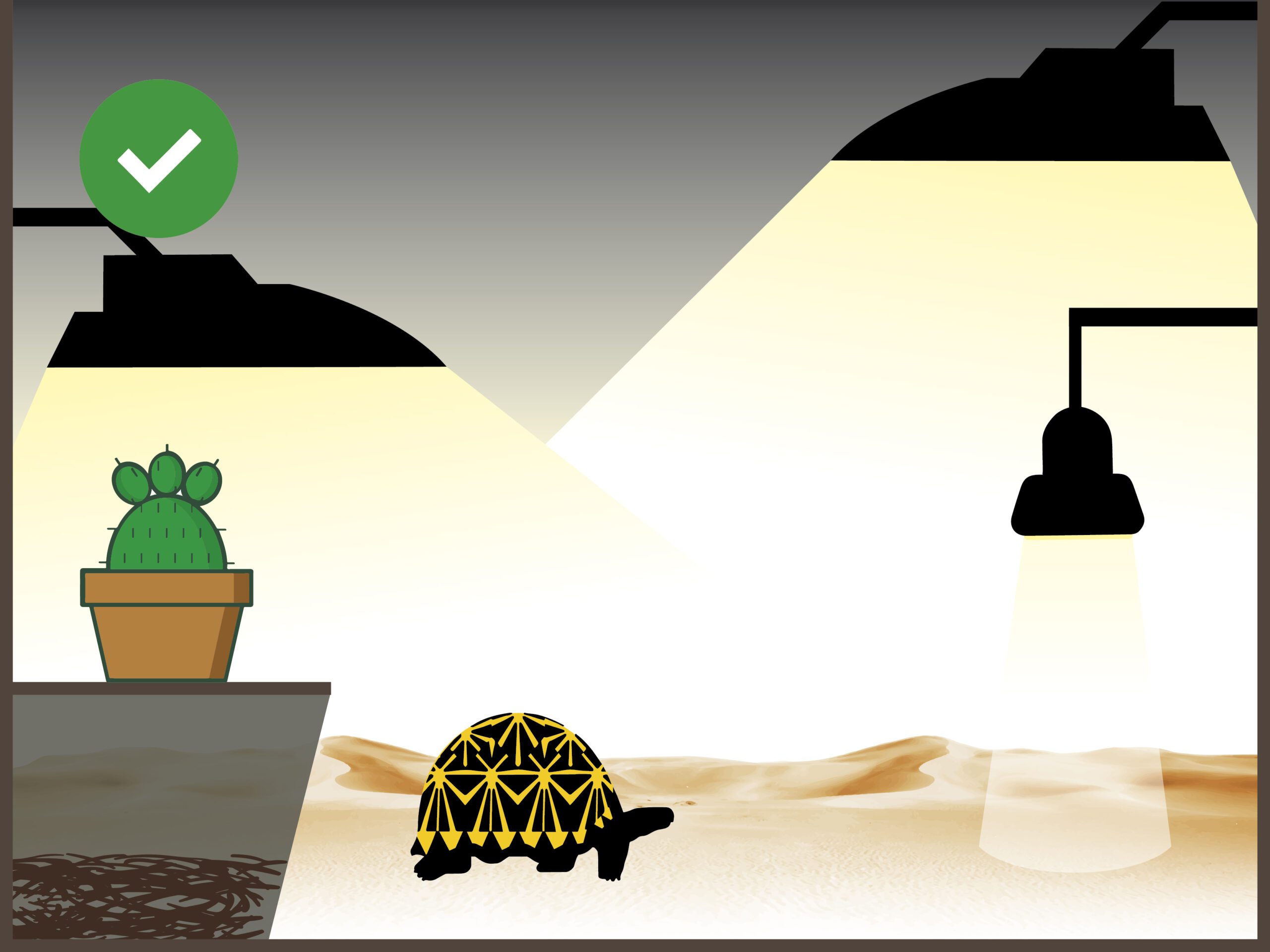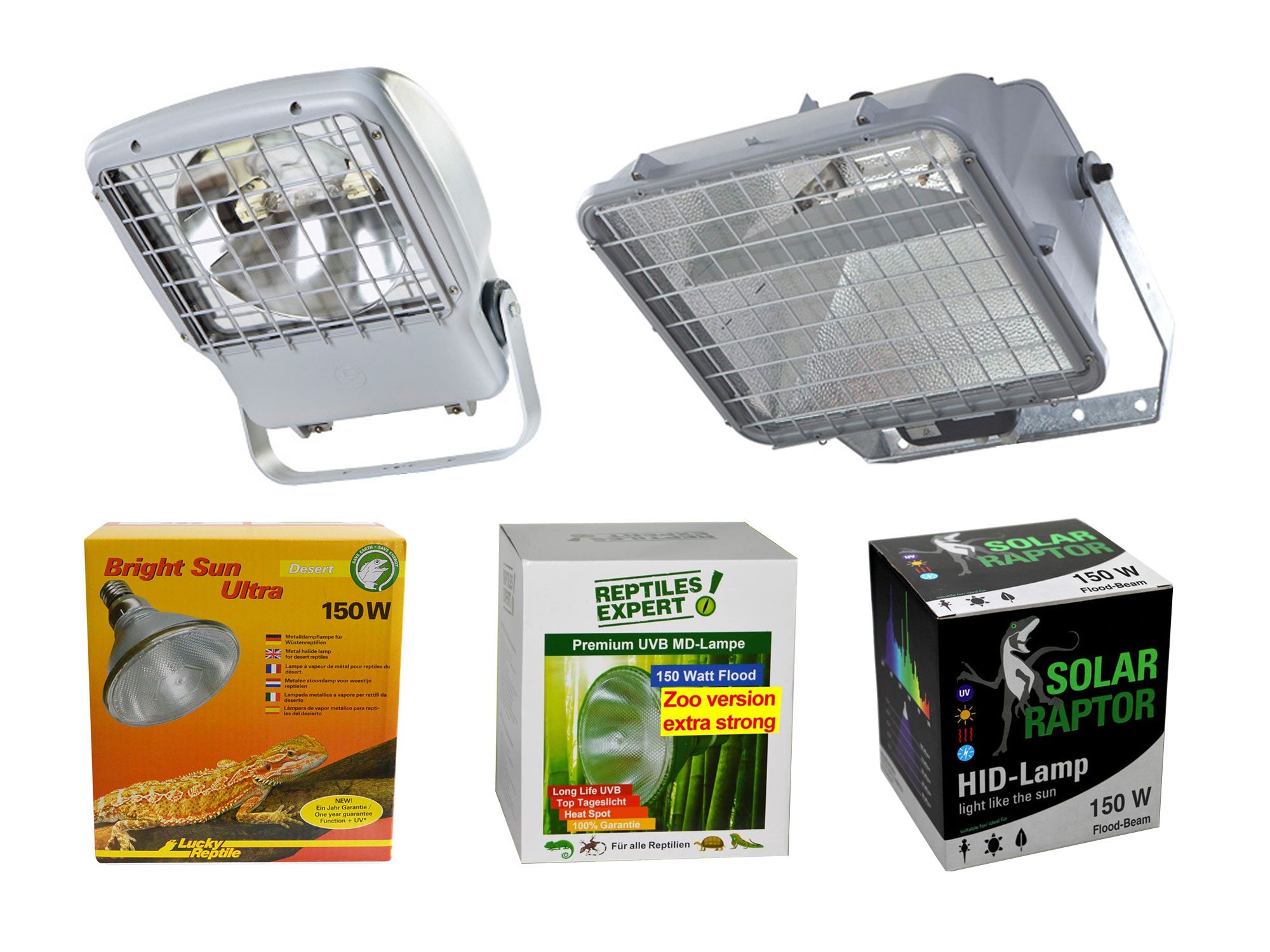Energiequelle Sonne
Der Südwesten Madagaskars ist eine trockene, heisse und von der subtropischen Sonne durchflutete Region. An der Küste wird das Sonnenlicht noch zusätzlich vom Meer reflektiert, so dass die lokale Flora und Fauna das ganze Jahr einer relativ hohen und direkten Sonnenstrahlung ausgesetzt sind. Als typische Bewohnerin dieser semiariden Zone ist auch der gesamte Organismus von Astrochelys radiata optimal an intensives Sonnenlicht angepasst. Der gesamte Aktivitätszyklus von Astrochelys radiata wird durch das Wandern der Sonne und der damit verbundenen Helligkeit und Temperatur beeinflusst. Licht wird von Schildkröten primär mit Wärme assoziiert, welche benötigt wird, um aktiv zu werden und um auf eine optimale Stoffwechseltemperatur zu kommen. Die im Habitat vorherrschende Lichtmenge, das Lichtspektrum und die Lichtintensität sind aber auch essenziell für die Gesundheit und das Wohlbefinden von Astrochelys radiata. Die Eigenschaften und die Zusammennsetzung des natürlichen Sonnenlichts haben einen direkten Einfluss auf den Hormonhaushalt, den Stoffwechsel, die Vitamin D Synthese und das Immunsystem der Tiere.
Strahlenschildkröten sind besonders heliophile Reptilien. Deshalb gibt es in der Haltung nur eine optimale Lichtquelle und das ist das natürliche Sonnenlicht. Dieses kann weder durch HQI noch andre professionelle UV-Leuchtmittel dauerhaft ersetzt werden. Wann immer möglich sollten die Tiere in menschlicher Obhut Zugang zu natürlichem Sonnenlicht haben, je mehr desto besser. Im europäischen Sommer ist der tägliche Aufenthalt in einem sonnigen Aussengehege ein zwingendes Muss und in der kalten Jahreszeit lässt sich eine tageslichthaltige Indoorhaltung am besten in Wintergarten- oder Gewächshaus ähnlichen Unterkünften bewerkstelligen. Haltungskonzepte, die das natürliche Tageslicht miteinbeziehen sind klar im Vorteil und helfen nebenbei auch Material- und Stromkosten zu sparen (siehe Abb. 1). Indoorhaltungen ohne Zugang zu natürlichem Tagesicht müssen bei schlechtem Wetter und während der kalten Jahreszeit mit professionellen, tageslichtähnlichen Leuchtmitteln grosszügig ausgeleuchtet werden. Ein häufiger Fehler in diesem Zusammenhang ist eine zu geringe Basisausleuchtung des Innengeheges. Mindestens 2/3 der gesamten Indoorfäche sollten während 8-10 Stunden mit tageslichtähnichen Leuchtmitteln grossflächig und hell ausgeleuchtet sein! Eine Beleuchtung, die nur aus isolierten und begrenzen Lichtkegeln unterhalb der Spots besteht ist ungenügend und irritiert die Schildkröten in der räumlichen Lichtwahrnehmung (siehe Abb. 3). Eine optimale Ausleuchtung einer Indooranlage besteht immer aus einer höher hängenden und flächigen HQI-Basisbeleuchtung und tiefer hängenden HQI-Spots, die sowohl für Wärme als auch ausreichendes UV-Licht sorgen (siehe Abb. 2).
Handelsübliche Terrarienbeleuchtungen werden von uns Menschen in der Regel intensiver und heller wahrgenommen als von Reptilien, dabei erreichen diese künstlichen Leuchtmittel nicht annähernd die Intensität und Qualität von natürlichem Sonnenlicht. Werden Strahlenschildkröten unter suboptimalen Lichtverhältnissen gehalten, wandern sie meist tagelang unruhig und nach mehr Sonnenlicht suchend im Gehege umher, was vom Halter oft irrtümlich als reguläre Tagesaktivität interpretiert wird. Bleibt der Lichtmangel bestehen, werden die Tiere zunehmend inaktiv und verkriechen sich in Verstecke, um die ungünstige Lichtsituation durch das Herunterfahren des Stoffwechsels zu kompensieren. Nach Tagen werden die Tiere aber dann völlig inappetent und lethargisch und bewegen sich kaum noch von der Stelle. Ein akuter Licht- bzw. UV-Mangel hat für Strahlenschildkröten immer sowohl mentale als auch physische Konsequenzen. Die Zusammenhänge sind komplex und stehen in Wechselwirkung zueinander. Ein unausgeglichener und schwankender Hormonhaushalt aufgrund von Lichtmangel macht die Tiere depressiv und apathisch. In diesem Zustand kann weder weitere Energie durch Futter aufgenommen noch wichtiges Vitamin D synthetisiert werden. Diese Mangelerscheinungen haben einen gestörten Stoffwechsel zur Folge, was wiederum zu einer ungünstigen und nachhaltigen Schwächung des Immunsystem führt. Neben irreversible Knochen-, Panzer- und Organschäden können so auch plötzlich aufflammende Infektionen zum schnellen und qualvollen Tod der Tiere führen.
Bitte beachten Sie, dass der gesamte Organismus von Astrochelys radiata evolutionsbedingt an die im Habitat herrschenden Lichtverhältnisse angepasst ist. Es gibt kein künstliches Leuchtmittel, welches das natürliche Sonnenlicht langfristig in seinen Qualitäten und Eigenschaften annähernd imitieren bzw. ersetzen kann! Nur das natürliche Sonnenlicht enthält in seiner Intensität und Zusammensetzung alle wichtigen Komponenten, welche für die Gesundheit und das Wohlbefinden von Astrochelys radiata notwendig sind. Es ist nicht möglich eine Strahlenschildkröte ohne regelmässigem Zugang zu natürlichem Sonnenlicht gesund zu halten. Je länger eine Strahlenschildkröte ohne natürliches Sonnenlicht auskommen muss, desto höher ist die Wahrscheinlichkeit von Mangelerscheinungen, gravierenden Stoffwechselstörungen und einem geschwächten Immunsystem. Aus diesem Grund sind Strahlenschildkröten absolut ungeeignet für eine ganzjährige Indoor- bzw. Terrarienhaltung. Wir halten auch ein regelmässiges Zuchtprogramm von Astrochelys radiata in einer Indoorhaltung, ohne Zugang zu natürlichem Sonnenlicht, für ausgeschlossen. Eine Haltung von Astrochelys radiata ohne regelmässigen und direkten Zugang zu natürlichem Sonnenlicht (Gartenhaltung!) ist nicht artgerecht und Tierquälerei!
Verwendete Leuchtmittel in der Indoorhaltung
Unser Schildkrötenhaus hat ein schräg abfallendes und nach Süden ausgerichtetes Dach mit zwei grossen, eingelassenen und temperaturgesteuereten Klappfenstern, durch die selbst an bewölkten oder regnerischen Tagen immer diffuses Tageslicht fällt. Im Sommer können die Tiere sich selbständig vom Innen- ins Aussengehege begeben und mit der Sonne wandern. Trotz grosser Bemühungen möglichst viel europäische Sonne in den Tagesablauf unserer Strahlenschildkröten zu integrieren, reichen die hiesigen Sonnenstunden in der Zentralschweiz bei weitem nicht an subtropische Verhältnisse heran. Deshalb ist es an kalten und lichtarmen Tagen durchaus notwendig in der Indooranlage noch zusätzlich mit HQI-Strahlern mehr Tageslicht zu simulieren. Haben unsere Strahlenschildkröten jedoch die Wahl sich unter einem Strahler oder in einem Lichtkegel unterhalb des Dachfensters aufzuhalten, bevorzugen sie immer die intensive Lichtfarbe des natürlichen Tageslichts.
Saisonal verwenden wir im Innengehege als Basisbeleuchtung mehere 400 Watt HQI-Strahler sowie an exponierten Stellen einige Lucky Reptile Bright Sun Desert Strahler 150 Watt mit Vorschaltgerät. Die 400 Watt HQI-Strahler leuchten bei einem Abstand von ca. 50 cm vom Boden eine Fläche von 0.5×0.6 m aus (Lux: 60000/30cm). Neben einer grossflächigen Basisausleuchtung muss pro adultes Paar mit einem tieferhängenden, grossen HQI-Strahler für die Wärme und UV Aufnahme gerechnet werden. Trotz einer komfortablen Mischlichtsituation mit natürlichem Tageslicht, das durch die Dachfenster fällt, werden an exponierten Stellen im Innengehege, wie z.B. auf dem Legehügel, zusätzliche UV-, Licht- und Wärmequellen benötigt. Wir achten immer darauf, dass unsere Strahlenschildkröten in der kalten Jahreszeit nie länger als 4-5 Monate am Stück (ca. November bis März) in der Indooranlage künstlichen Leuchtmitteln ausgesetzt sind. Damit unsere Strahlenschildkröten möglichst viel und lange vom natürlichen Sonnenlicht profitieren können, lassen wir sie bei milder und trockener Witterung auch in den Übergangszeiten (November/März), wenn auch nur für ein paar Stunden, ins Freigehege. Dabei spielt weniger die Aussentemperatur (ab 15°C) eine Rolle als das Erlebnis von einem sonnigen, hellen Tag. Ein direkter Zugang vom Innen- ins Aussengehege ermöglicht es den Tieren sich jederzeit wieder selbständig und rasch im beheizten Innenraum aufzuwärmen.
Aufgrund der unterschiedlichen Dimensionen und Voraussetzungen von Indooranlagen ist eine allgemeine Leuchtmittelempfehlung für Strahlenschildkröten nicht möglich. Die Wahl und Anzahl der geeigneten Leuchtmittel richtet sich nach der Grösse bzw. Höhe der Indooranlage sowie nach der auszuleuchtenden Fläche und Anzahl gehaltener Tiere. Alle Leuchtmittel und Montageabstände müssen aus Sicherheitsgründen immer an die jeweiligen Gegebenheiten angepaßt werden. Beachten Sie auch die Betriebs-, Montage- und Sicherheitsanleitungen des jeweiligen Herstellers! Ausleuchtung und Wärme sollten immer vor dem Einzug der Tiere mehrfach und über einen längeren Zeitraum kontrolliert werden. Bei allen UV-Lampen nimmt die UV-Strahlung nach einer gewissen Brenndauer kontinuirlich ab. Auch wenn die Lampen noch hell leuchten wird ca. nach einem Jahr keine ausreichende UV- Strahlung mehr abgegeben. Obwohl es wirtschaftlich und ökologisch fragwürdig ist, empfehlen wir immer alle Leuchtmittel nach einem Jahr Brenndauer präventiv zu ersetzen, um eine kontinuirliche und optimale UV Strahlung zu gewärleisten. Möchte man HQI-Lampen aber länger als ein Jahr nutzen, ist ein zusätzlicher Einsatz von starken UV Lampen wie z.B. der Osram Vitalux über einen Zeitraum von 3-4 Stunden über die Mittagszeit für eine ausreichende UV- Versorgung ergänzend empfohlen.
Die folgenden Lichtquellen haben sich in der Indoorhaltung als Licht-, Wärme- und UV-Beleuchtung sehr gut bewährt:






